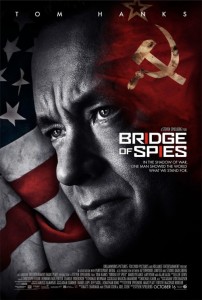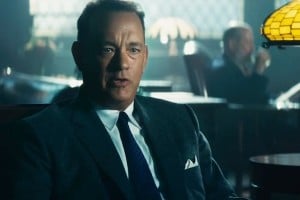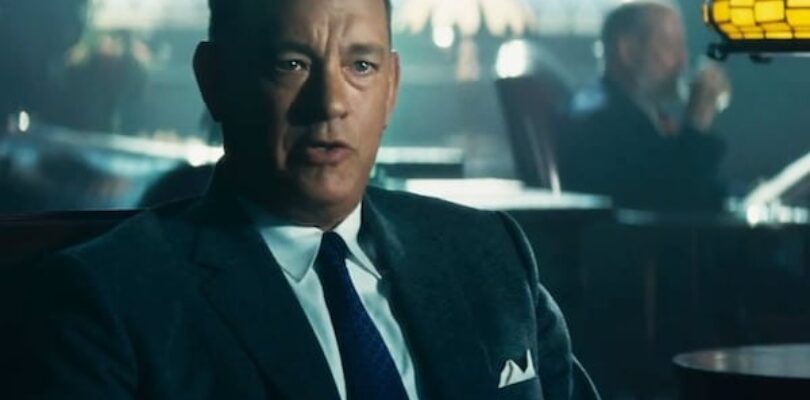The Tom Hanks-starring period piece Bridge of Spies is Steven Spielberg’s best and most entertaining film since…well, his last Tom Hanks-starring period piece. In the decade-plus since the delightful Catch Me If You Can, Spielberg’s made good starchy period pieces (Lincoln), dull starchy period pieces (War Horse) and a few old-school adventure  pictures that still can’t shake a certain sedateness (War of the Worlds, The Adventures of Tintin). But in this witty Cold War thriller, Spielberg gets his groove back – or at least as much as he’s got to offer these days.
pictures that still can’t shake a certain sedateness (War of the Worlds, The Adventures of Tintin). But in this witty Cold War thriller, Spielberg gets his groove back – or at least as much as he’s got to offer these days.
It helps that the movie has a pretty wild true story to start with as its premise. It’s 1957 and tenacious New York insurance lawyer James Donovan (Hanks) is assigned to defend a captured Soviet spy, Rudolf Abel (Mark Rylance). Donovan is initially reluctant to take the case of such an obvious persona non grata, but he applies himself to the task out of a strong commitment to the integrity of his profession. Donovan helps secure a prison sentence rather than the death penalty for Abel, arguing that the spy could make a valuable bargaining chip with the USSR in the future. The CIA takes that suggestion in 1962, offering Abel in trade to the USSR for captured U.S. spy pilot Francis Gary Powers – but given tensions between the two world powers, the agency wants Donovan to conduct the negotiation as a private citizen. Donovan agrees to travel to East Germany to make the deal, but he’s got a plan of his own in mind: he’s not leaving without bringing home a much lower-priority captive, American student Frederic Pryor, as well.
It’s a twisty pile of characters and relationships, and Spielberg gives it plenty of space to breathe over the course of a nearly two-and-a-half-hour running time. But while there may be a lot of chitchat, it’s all very high-stakes chitchat, with a script that keeps us constantly aware of both the geopolitical weight and the very personal emotions that inform the negotiations. Matt Charman wrote the original screenplay, but it’s hard not to attribute much of the film’s sly sense of humor and quick-witted repartee to the Coen brothers, who revised the script.
 This all comes to life on screen with great energy, although Spielberg allows his cast to generate that crackle themselves in relatively long takes rather than creating patter through editing. (The great cinematographer Janusz Kaminski proves an unexpected weak link in setting this mood, rendering most of the film in overbearingly gloomy blues with glaring backlighting.) But the spectacular cast is more than up to the task, with Hanks clearly relishing his meaty lead role without chewing the scenery. He cannily portrays a man both genuinely weary of the situation he’s been thrown into, but thoroughly aware of how to play that weariness to his own benefit. For a few significant chunks of the movie he’s got a terrific foil in Rylance, who makes Abel a true cipher in a subtly comic performance upon which the movie’s climactic scene pivots. The rest of the cast does fine support work, but Hanks and Rylance are the deserving stars of the show.
This all comes to life on screen with great energy, although Spielberg allows his cast to generate that crackle themselves in relatively long takes rather than creating patter through editing. (The great cinematographer Janusz Kaminski proves an unexpected weak link in setting this mood, rendering most of the film in overbearingly gloomy blues with glaring backlighting.) But the spectacular cast is more than up to the task, with Hanks clearly relishing his meaty lead role without chewing the scenery. He cannily portrays a man both genuinely weary of the situation he’s been thrown into, but thoroughly aware of how to play that weariness to his own benefit. For a few significant chunks of the movie he’s got a terrific foil in Rylance, who makes Abel a true cipher in a subtly comic performance upon which the movie’s climactic scene pivots. The rest of the cast does fine support work, but Hanks and Rylance are the deserving stars of the show.
Despite all the nuclear brinksmanship, Bridge of Spies is something Spielberg hasn’t really managed to be in quite a while: fun. It’s heartening to see the director continue to work with the period pieces that seem to have primarily occupied his mind for the past decade, while still tapping into the sense of play that more frequently characterized his early work. Spielberg’s next film is a children’s fantasy story, an adaptation of Roald Dahl’s The BFG, with Rylance as the titular jovial giant. Here’s hoping Spielberg can continue to lighten up a bit without Hanks or the Coens in tow.[box_info]WHERE TO WATCH (powered by JustWatch)
[/box_info]

